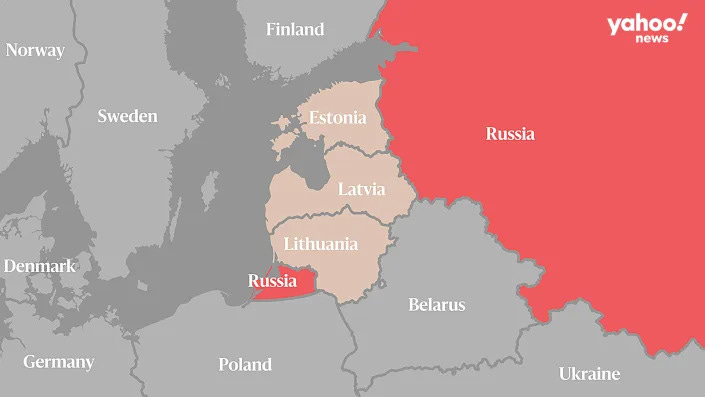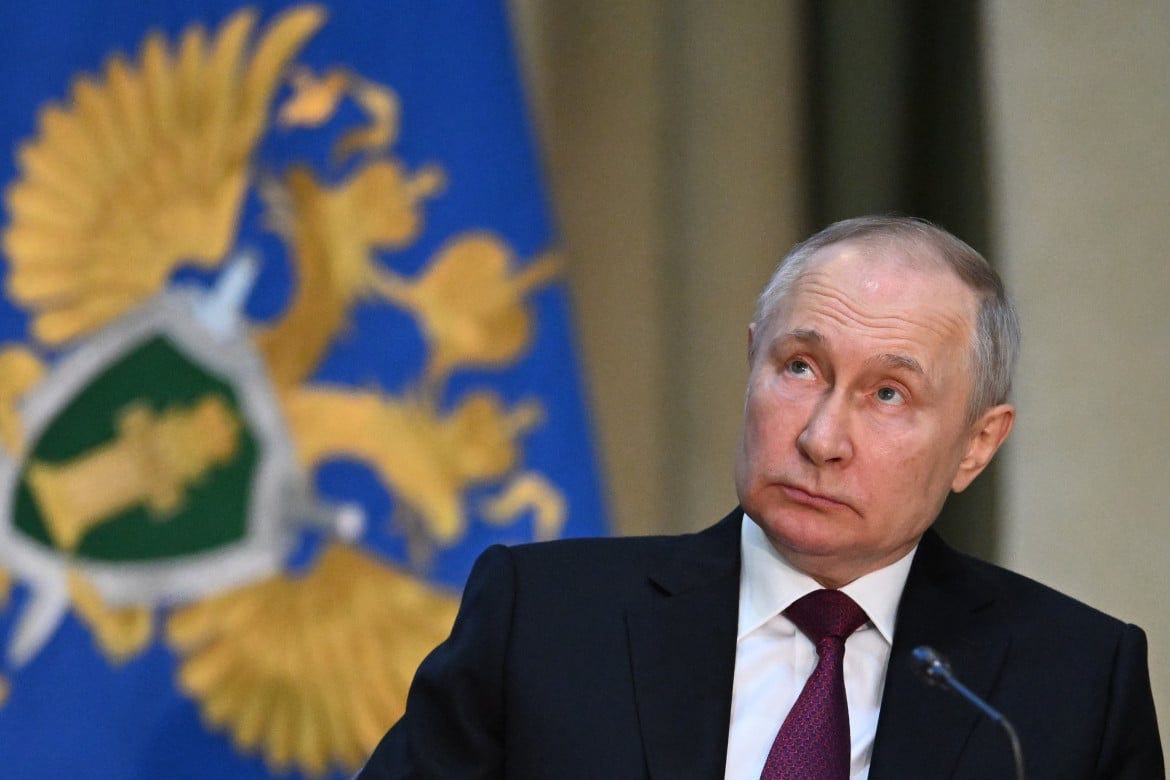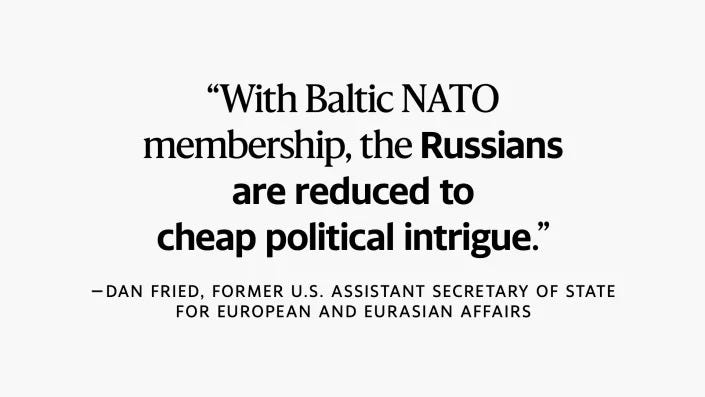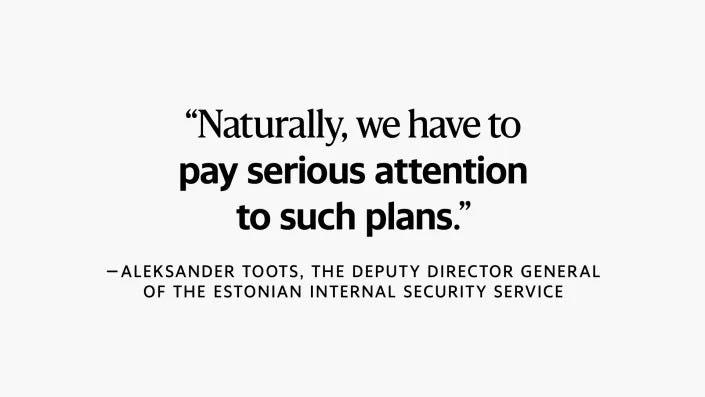May 1: Weiss & Roonemaa, Putin's plans to keep the Baltics in check
Yahoo News as published on its website April 26, 2023
Exclusive: Putin's plans to keep the Baltics in check
The Russian Presidential Administration’s strategy documents for Estonia, Latvia and Lithuania show a Kremlin “out of touch” with realities in the NATO and EU member states at its doorstep.
By Michael Weiss & Holger Roonemaa, Yahoo News, April 26, 2023
Yahoo News has obtained confidential strategy documents drawn up by the Kremlin that reveal Russia’s ambitious plans to exert its influence in the Baltic states of Estonia, Latvia and Lithuania.
Formerly annexed states of the Soviet Union, all three are now proud NATO and EU members with governments fiercely critical of Russia’s foreign policy.
Among other things, the documents show Moscow’s intention to thwart the construction of NATO military bases, weaken the local democratic governments, expand Russian cultural and linguistic influence and bolster pro-Kremlin political organizations. But in a running theme throughout the documents, which were drafted in 2021, Russia’s subsequent invasion of Ukraine has undermined almost every aspect of the plans.
“Estonia, our allies and partners have long been aware of Russia’s interest to use hybrid tactics to pursue their goals and try to assert their influence in other countries,” Estonian Prime Minister Kaja Kallas told Yahoo News. “It’s Russia’s classic playbook — many of their tactics are taken straight from the KGB.
“We know our neighbor,” she continued. “Our job is to continuously share our knowledge of Russia’s actions, build resilience and stand against Russia’s direct and indirect attempts of influence. We have had to bolster our defenses to stand up against any threat, including hybrid threats. And it’s also crucial to discuss these matters publicly.”
Ingrida Šimonytė, the Lithuanian prime minister, similarly told Yahoo News after reading the Russian plan for her country that it was all something “you would usually suspect.”
“Latvia has been facing Russia’s desire to strengthen and expand its influence in neighboring countries since the restoration of independence,” said Krišjānis Kariņš, the Latvian prime minister. “Latvia maintains a realistic view of Russia's foreign policy and its initiatives. At the international level, Latvia actively advocates for and promotes Russia’s isolation.”
The documents were drafted by the Russian Presidential Administration’s Directorate for Cross-Border Cooperation, which formulated similar plans, previously revealed by Yahoo News, for the creeping annexation of Belarus and the toppling of Moldova’s pro-Western government.
Despite its benign name, the Directorate for Cross-Border Cooperation is staffed by Russian intelligence officers from the three main spy services, the FSB, SVR and GRU, respectively representing the domestic, foreign and military agencies. The directorate’s real agenda is bringing nations back into Russia’s sphere of influence.
Yahoo News obtained these documents together with its consortium partners Delfi Estonia, Sweden’s Expressen, London-based Dossier Center, Latvia’s Re:Baltica, Lithuanian Public Broadcaster LRT, Süddeutsche Zeitung, German radio networks WDR and NDR, the Kyiv Independent, Poland’s FrontStory and Central European media outlet VSquare.
With populations between 1 million and 3 million, Estonia, Lithuania and Latvia are all small countries dwarfed by Russia but strategically located on the easternmost edge of both NATO and the EU. Annexed by Moscow as part of a deal between Adolf Hitler and Joseph Stalin, the three now-liberal democracies restored their independence when the Soviet empire collapsed. Their alliance with the West is a source of deep annoyance to Vladimir Putin’s regime, especially because there are hundreds of thousands of ethnic Russians living inside their borders.
Like the Belarus and Moldova documents, Russia’s plans for the Baltic countries are broken up into three chapters: political, military, military-technical and security-related objectives; trade and economic; and humanitarian or society-related goals. All chapters are subdivided into three distinct time frames: the short term (by 2022), the medium term (2025) and the long term (2030).
Each country in the latest Kremlin documents is addressed in two separate texts. The first lists the “strategic interests of the Russian Federation” in different areas and at different periods. The second text outlines the risks that lie in Russia’s path.
A European intelligence source described the Russian Presidential Administration as a kind of think tank that, in addition to drafting Russian foreign policy prescriptions, also decides on the conduct of disinformation campaigns — ways to weaken preexisting ties between and among allies. “The Baltic papers are not about gaining influence in the respective countries,” the source told Yahoo News, speaking on the condition of anonymity. “They’re rather a containment policy to prevent Russian influence from dwindling any further.” Few in the Kremlin, the source added, really think the Baltic states can be “brought back” into the Russian fold. A more realistic plan would be sowing internal opposition to keep them from slipping more completely into the Western one.
A different European intelligence official, who is aware of the documents, said it was very unlikely that the authors were aware of the forthcoming invasion of Ukraine, given how remote the prospects for success of their schemes now look in hindsight.
Indeed, Europe is far more united against Russian influence than it was before the attack on Ukraine. All three Baltic states have poured hundreds of millions of dollars of military aid into Ukraine, making them per capita the three largest contributors to Ukraine’s defense, whose struggle they see as a bulwark against the Kremlin’s designs for their own countries. Estonia alone has spent $440 million on military assistance for the embattled nation, more than 1% of its gross domestic product, and, as Yahoo News first reported, is transferring its entire inventory of 24 FH70 towed howitzers to Kyiv.
“Russia’s plans to gain leverage over Estonia, Latvia and Lithuania remind me why their NATO accession was such a good idea,” Dan Fried, the former U.S. assistant secretary of state for European and Eurasian affairs, told Yahoo News. “Without Baltic NATO membership, Russia would have invaded by now. With Baltic NATO membership, the Russians are reduced to cheap political intrigue.”
Though each Baltic nation is distinct, there are commonalities in Russia’s proposed approaches to all three. In the stated “humanitarian sphere,” the promotion of Russian culture and the preservation of Russian-language education are paramount.
Estonia is home to about 300,000 ethnic Russians, about 24% of the population. Latvia is home to around 471,000, roughly 25% of its population. Lithuania, the most populous of the Baltics, with 2.8 million people, is also host to the smallest ethnic Russian diaspora: 140,000, a mere 5%.
Moscow has for years routinely criticized all three Baltic states for their reluctance to acknowledge Russian as a state language and for allegedly discriminating against ethnic Russians.
Estonia and Latvia have both recently adopted language reforms that will gradually bar kindergartens and schools from teaching in Russian. At the same time, both countries have kept the door open for extensive opt-in Russian language and culture classes.
To counter such efforts, Russia’s Estonia strategy directly calls for the “propaganda of Russian culture,” including the cultivation of children and the training of “talented Russian-speaking youth” in Russian universities.
Analysts and intelligence officials have long argued that language and culture are integral to the Kremlin’s “compatriots” policy, by which Moscow claims for itself the role of patron of the world’s ethnic Russians and Russian speakers, and which it believes it has the right to defend by military means. Moscow’s coercive form of cultural outreach is prosecuted by a host of Russian government agencies, including the Ministry of Foreign Affairs and its culturally oriented subsidiaries Rossotrudnichestvo and the Russkiy Mir (“Russian World”) Foundation, both of which previously had offices throughout Europe but now face EU and NATO sanctions.
A medium-term goal for Latvia is the “opening of a school at the Russian foreign mission in Riga as a potential center for the implementation of a set of measures to maintain and strengthen the position of the Russian language, literature, culture and education in Latvia.”
Although it sounds innocuous, such a “school” could easily act as a clearinghouse for the recruitment of Russian spies and agents of influence, according to Latvia’s Constitution Protection Bureau (SAB), the foreign and counterintelligence service. SAB sent a written statement to Yahoo News after reviewing the Latvia strategy document, noting that Russia’s intelligence services play an outsize role in the country. “This includes obtaining intelligence information and conducting research on the possibilities of influence, working with agents of influence, including providing financing to various individuals and groups in Europe to use as a lobby for Russian interests,” the statement read. “The Kremlin’s interest lobby is often carried out through economic interests and businessmen whose activities are related to Russia.”
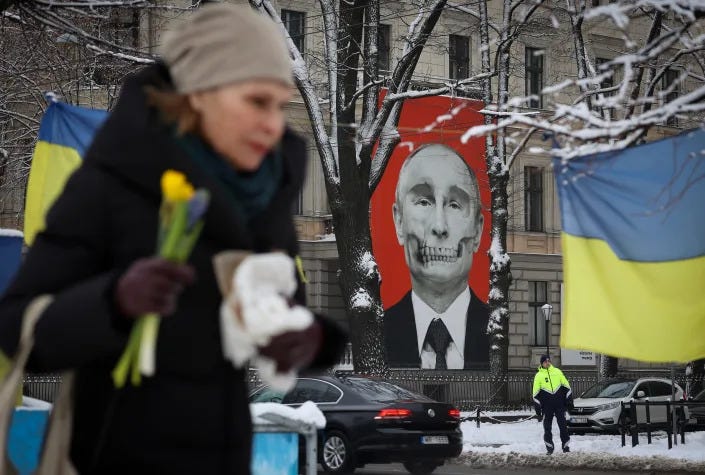
Another explicit aim of the Russian documents is to prevent “the establishment of NATO military bases” in Latvia and Lithuania. National air and army installations in the Baltic countries host troops and units from NATO allies on a rotating basis.
But since Russia’s full-scale invasion of Ukraine last year, the alliance’s footprint has only grown in the Baltics. The number of allied troops in Estonia alone is already near 2,000, and the U.S. sent an infantry company equipped with High Mobility Artillery Rocket Systems (HIMARS) to Estonia just before last Christmas.
The next goal in the documents is the creation of the conditions for “weakening the influence of the Western countries in the military-political, trade-economic and humanitarian spheres” and “counteracting the attempts of anti-Russian Estonian political forces to falsify history.”
Falsifying history, in this context, refers to Estonia’s memorialization of its loss of independence in 1940 following the Soviet annexation; its heroizing of “forest brothers,” or anti-Soviet partisans, during the long years of occupation; and its celebration of reclaimed independence upon the demise of the Soviet Union in 1991. These themes, integral to Estonia’s modern national identity, are falsely rebranded by the strategy document as the “glorification of Nazism.”
Part and parcel of that alleged glorification is Estonia’s decision to remove or relocate Soviet-era World War II monuments. In 2007, a decision to move the so-called Bronze Soldier from its perch at an intersection in central Tallinn to an Estonian military cemetery caused riots by ethnic Russians, perhaps encouraged from abroad. Then it led to a massive cyberattack against the country, which temporarily crippled Estonia’s expansive digital commerce and banking sectors. One unnamed Estonian official told the BBC in 2017 that the attacks, traced to Russian IP addresses, were “orchestrated by the Kremlin, and malicious gangs then seized the opportunity to join in and do their own bit to attack Estonia.”
In a symbol of how these three small countries, numerically outmatched by Russia’s military, have adapted to inhabiting a hostile piece of geography, Estonia has since grown into a cybersecurity powerhouse, including in eastern Ukraine. Its foreign intelligence service, Välisluureamet, is considered to be one of the premier collectors of signals intelligence, or communications intercepts, in NATO. Moreover, the bulk of Estonian society has only grown more inhospitable to Russian influence operations and espionage since the invasion of Ukraine last February. Since then the EU has expelled more than 600 Russian diplomatic staff, 36 of them from Estonia alone, a remarkable proportion given the country’s small population of just 1.3 million.
Estonia, Latvia and Lithuania have also since barred the entry of Russian citizens, including those fleeing conscription following Putin’s mass mobilization order in September, a decision criticized by other EU members. A big motive for this controversial decision, hinted Mikk Marran, the recently retired head of Välisluureamet, wasn’t just showing solidarity with Ukraine but safeguarding Estonian national security. “Hosting a few hundred thousand military-aged men, aged 18 to 35 — I’m not so sure that’s a good idea for any country so close to Russia,” Marran said in a wide-ranging interview last November.

Yahoo News showed the document to Aleksander Toots, the deputy director general of the Estonian Internal Security Service. “Naturally, we have to pay serious attention to such plans,” he said. “But we also need to understand which point in time the documents originate from. Maybe the set strategic goals have already become obsolete because of changed circumstances. If you see that the plans are being implemented, you need to do everything you can to put brakes on it.”
One of the most dated chapters in all the Baltic documents concerns Russia’s plans to influence local economies, trade and business. A medium-term goal is increasing Russian exports and bilateral trade and foreign direct investment. This plan was clearly based on the relationships that were burned by Moscow’s war of aggression against Ukraine.
“They want to increase exports to Estonia by 2022,” Toots said, “but last summer Russia itself decided to close the Narva-Ivangorod bridge to trucks in retaliation for Estonia’s support for Ukraine,” referring to the border crossing in Estonia’s northeast. “How can you increase exports if you close the main channel?”
Stoking pro-Russian sentiment in Estonian society and within the political and military elites is listed as an ever-present goal throughout all three periods. So is limiting the influence of nationalist elements and creating new public associations and nongovernmental organizations that promote cooperation with Russia.
“It’s the same thing the Russians have been doing for 30 years,” Toomas Henrik Ilves, the former president of Estonia, told Yahoo News after reviewing the strategy documents. “What strikes me is the same out-of-touch understanding of the reality of Estonia evinced already with the invasion of Ukraine. They just don’t understand what’s happening in our country, or in Latvia and Lithuania, for that matter.”
Per the documents, a short-term goal for Estonia is the “formation of new public structures, foundations, NGOs and NGOs advocating cooperation with the Russian Federation.” Another short-term goal is working “with Estonian businessmen to explain the Russian Federation’s readiness to open up the Russian market to them, provided that Tallinn changes its foreign policy to be more pro-Moscow.”
This is a more practical goal than many of the others in the documents, according to experts. “Entrepreneurs are the most easily vulnerable and influenceable group,” said Toots. “Once a politician runs out of votes and power, he has nothing. But as long as businessmen have money, they will try to influence politics in their own interests.”
One of the most bizarre objectives stated in the Estonia strategy is the counteraction of Estonia’s alleged efforts to “foster separatist sentiments in the Russian regions [and] to create such sentiments among representatives of Finno-Ugric peoples living in Russia.”
Estonians, along with Finns and Hungarians, originate from the Finno-Ugric tribes, descendants of ancient inhabitants of Europe.

But the notion that Tallinn is trying to foment a separatist movement in its next-door neighbor reeks of projection, according to one senior Estonian intelligence official. “This is the stuff of Russian fantasy. It has zero correspondence to reality, but sounds like something they’d say because it’s exactly something they’d do and indeed have done in Georgia, Moldova and Ukraine” — three countries where Moscow has fostered independence movements among Russian-speaking minorities.
The strategy document for Lithuania, the most populous Baltic country, contains the most specific military requirements for Russia, starting with the short-term project of stopping the “build-up of the military presence of the United States and other NATO member countries” on Lithuanian territory. A medium-term follow-on is preventing the “deployment … of medium-range air defense/missile defense systems integrated into a single NATO air defense system” and reducing the “number and scope of NATO’s operational and combat training activities” in Lithuania.
But a large swath of that has already happened.
A NATO multinational battalion battle group is based in Rukla, Lithuania, in the central county of Kaunas. In the first two years of Enhanced Forward Presence, the Lithuanian Armed Forces state, “roughly 8 thousand allied soldiers from nine NATO allies have served in the unit on a rotational basis.” A NATO summit in Vilnius is scheduled for July, and a big item on the agenda will be integrated air defenses along the alliance’s eastern flank, something Lithuanian President Gitanas Nausėda has called for.
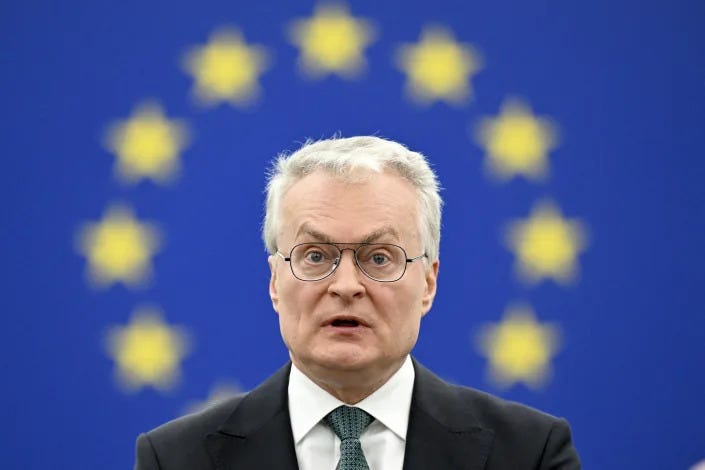
Another Kremlin preoccupation with Latvia is “ensuring the necessary protection of Russian assets … including in terms of possible court decisions on freezing or arresting the property of the state or private companies.” Latvia has long been a notorious hub for Russian money laundering, with banks being the gateway for billions of dollars in Russian wealth entering the European Union. Yet this access to Western markets is now also closed thanks to the Latvian authorities' shuttering of the dirty banks and, more recently as well, the Western sanctions due to the war.
“The current objectives in Latvia,” said the Latvian intelligence service SAB, “are to divide the Latvian society as much as possible, promote tension and dissatisfaction with the state authorities, create contradictions among Western countries to make unified decision-making difficult.”
According to the documents focusing on potential risks Russia envisions in pursuing its objectives in the Baltic countries, the increased militarization of NATO, sanctions, resurgent “Nazism,” and suppression of Russian language, culture and education in the Baltic states are listed. The first two are now accomplished facts, again thanks to Russia’s war on Ukraine.
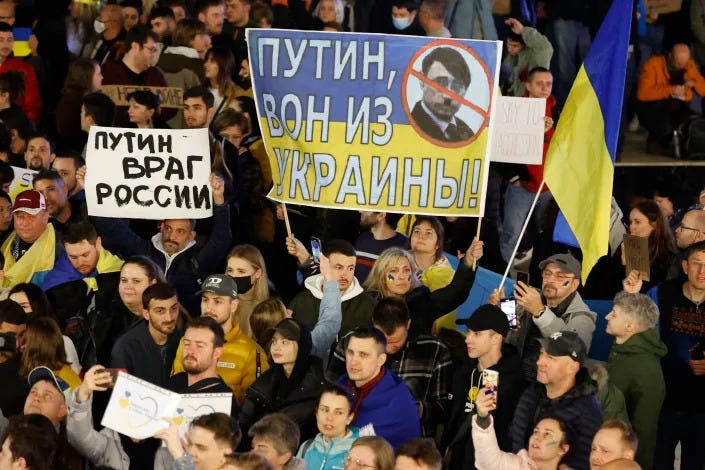
As a whole, the Kremlin’s designs on the Baltics reflect time-tested Soviet tactics, Marius Laurinavičius, a Lithuanian expert on international affairs, told Yahoo News. “This is the old KGB method: ‘We should weaken our enemies. And the best way to weaken them is from inside, not from outside.’ What they are good at is dividing societies, creating problems, creating conflicts.”
And if the Directorate for Cross-Border Cooperation sounds misguided in its ambitions for the Baltics, that may be because it needs to justify its existence to the higher-ups in the Kremlin.
Toots, the deputy director of Estonia’s intelligence service, thinks the plans feature exactly the same kind of delusional thinking and hubris, predicated on poor intelligence and false premises, that led Russia to believe it could quickly sack Kyiv over a year ago. “Knowing how the Russian regime operates,” he said, “I can say that the employees there have a habit of lying to their bosses because the bosses don’t like to receive unvarnished accounts of the real situation. If you provide them with embellished stories, you will live in an illusion. The Russian system is built on everyone bluffing.”




